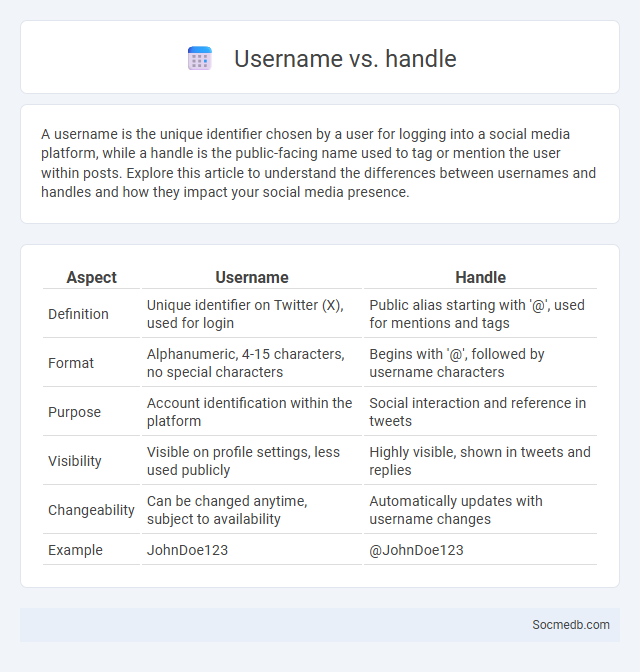
Photo illustration: Username vs Handle
A username is the unique identifier chosen by a user for logging into a social media platform, while a handle is the public-facing name used to tag or mention the user within posts. Explore this article to understand the differences between usernames and handles and how they impact your social media presence.
Table of Comparison
| Aspect | Username | Handle |
|---|---|---|
| Definition | Unique identifier on Twitter (X), used for login | Public alias starting with '@', used for mentions and tags |
| Format | Alphanumeric, 4-15 characters, no special characters | Begins with '@', followed by username characters |
| Purpose | Account identification within the platform | Social interaction and reference in tweets |
| Visibility | Visible on profile settings, less used publicly | Highly visible, shown in tweets and replies |
| Changeability | Can be changed anytime, subject to availability | Automatically updates with username changes |
| Example | JohnDoe123 | @JohnDoe123 |
Introduction to Usernames and Handles
Usernames and handles serve as unique digital identifiers across social media platforms, enabling users to establish their online presence and brand identity. These alphanumeric labels often combine personal names, interests, or keywords relevant to the user's niche, enhancing discoverability in search engines and within platform ecosystems. Optimal username selection improves social engagement, personal branding, and audience targeting by reflecting authenticity and relevance in the competitive digital landscape.
What is a Username?
A username is a unique identifier used to distinguish your profile on social media platforms, allowing others to find and interact with you. It often consists of a combination of letters, numbers, or symbols and is essential for account creation and login purposes. Choosing a clear and memorable username enhances your online presence and helps in building your digital identity.
What is a Handle?
A social media handle is your unique username or identifier used across platforms like Twitter, Instagram, and TikTok, allowing other users to find and interact with your profile easily. It typically includes the "@" symbol followed by your chosen name or alias, ensuring a consistent and recognizable digital presence. Your handle plays a crucial role in branding, communication, and networking within the social media landscape.
Username vs Handle: Key Differences
Usernames and handles serve distinct functions on social media platforms, with usernames acting as unique identifiers associated with a user's account profile, while handles are the clickable tags used for mentions and direct engagement. Usernames often appear in profile URLs and must be unique within a platform, whereas handles typically start with the "@" symbol and facilitate seamless user interaction and discovery. Understanding these differences enhances strategic branding and improves communication efficiency across social networks like Twitter, Instagram, and Facebook.
Platform Examples: Username and Handle in Action
Social media platforms like Instagram, Twitter, and TikTok utilize usernames and handles as unique identifiers, enabling users to connect and share content seamlessly. For instance, Twitter handles begin with "@" and serve as direct tags or mentions, enhancing engagement and discoverability. Instagram usernames, often combined with profile handles, facilitate personalized branding and audience interaction across diverse social media networks.
The Evolution of Online Identities
The evolution of online identities has transformed how individuals express themselves across social media platforms, blending personal branding with digital interaction. Algorithms now tailor content to your curated persona, making authenticity and privacy central to managing your online presence. Understanding this shift is crucial for navigating the balance between social engagement and digital reputation.
Choosing the Right Username or Handle
Selecting the right social media username or handle is crucial for building a recognizable online identity and enhancing searchability. Opt for a unique, concise, and easy-to-remember name that aligns with your brand or personal image while avoiding special characters that complicate user recall. Consistency across platforms strengthens brand cohesion and boosts visibility in social media algorithms.
Security Concerns: Protecting Your Online Identity
Social media platforms present significant security concerns due to data breaches, phishing attacks, and identity theft risks. Protecting your online identity requires strong, unique passwords, enabling two-factor authentication, and carefully managing privacy settings to limit personal information exposure. Regularly monitoring your accounts for suspicious activity ensures your digital presence remains secure from potential cyber threats.
Best Practices for Username and Handle Creation
Choose a username or handle that is concise, memorable, and consistent across platforms to enhance brand recognition and improve searchability. Incorporate relevant keywords related to your niche or industry to boost discoverability and optimize for SEO. Avoid special characters and excessive numbers to ensure easy typing and prevent user confusion.
Future Trends: The Role of Usernames and Handles
Usernames and handles will play a crucial role in shaping your online identity as social media platforms implement AI-driven personalized recommendations and enhanced security measures. These unique identifiers will evolve to support cross-platform integration, making it easier for users to maintain a consistent digital presence. The future of social media relies on innovative username systems that enhance discoverability, foster user engagement, and protect privacy.
 socmedb.com
socmedb.com